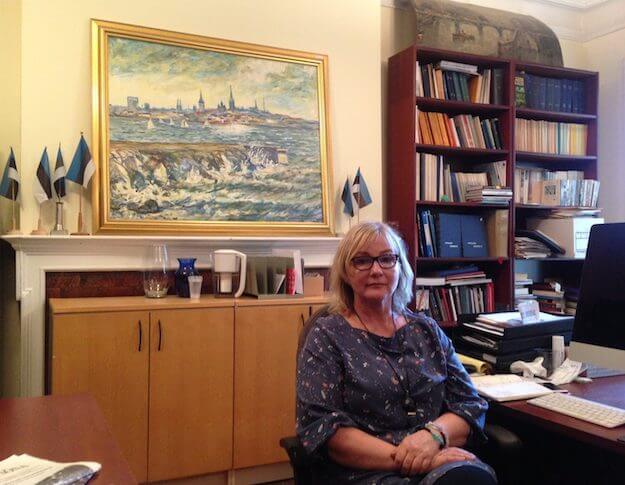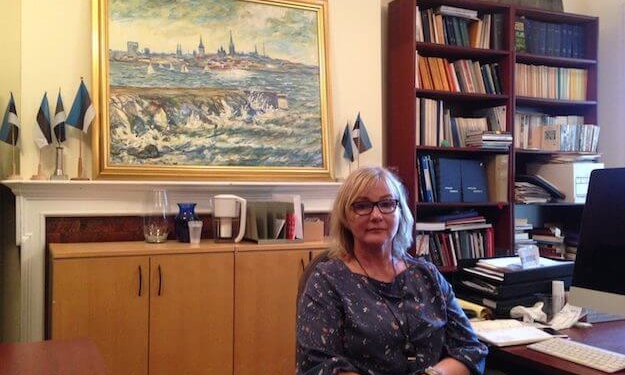
Kärt Ulman, editor of Vaba Eesti Sõna, at the paper’s office in Manhattan. Photo by Karen Pennar for Voices of NY
As I enter the Estonian House, a limestone townhouse on East 34th Street, I flash back to memories of the times I visited with my father when I was a child growing up in Manhattan. I remember my father purchasing Estonian bread in the café area, and greeting friends and acquaintances in his native Estonian – a complex, musical and, to me at least, mysterious tongue.
Standing in the wood-paneled parlor, I’m jolted back to the present by a cheerful voice welcoming me from above the stairwell, and I head up to the third floor. There, I meet Kärt Ulman, editor of the diaspora weekly newspaper Vaba Eesti Sõna (Free Estonian Word).
This year marks the 100th anniversary of the declaration of independence by the tiny Baltic nation of Estonia, and Vaba Eesti Sõna is offering regular and detailed coverage of celebrations being held here and overseas. A few days before coming to meet Ulman, I attended a concert at Alice Tully Hall, where Maaja Roos conducted the Esto-Atlantis Choir, with 100 singers from New York, Stockholm and the Estonian capital of Tallinn coming together especially to mark the centennial. For Estonians, music is in their lifeblood – every five years, the rousing Estonian Song Festival draws tens of thousands of singers and listeners, while the “Singing Revolution” marked by protests and songs that began in 1988 helped usher in Estonia’s nonviolent restoration of independence in 1991, after decades of Soviet rule.
The paper’s editor was also at the Alice Tully Hall concert, and we talk about the exceptional virtuosity and beauty on display there. Events like these, where Estonians gather, are fodder for the paper, which, said Ulman, has made a commitment to continue its coverage of the community in the U.S. through 2020, the centennial of the Treaty of Tartu. That treaty concluded the country’s initial battle for independence from the Russians, and ushered in a brief period of freedom for the northernmost nation of the Baltics.
Beyond 2020, though, it’s not clear that the newspaper will survive.
For nearly 70 years, Vaba Eesti Sõna has served the Estonian community in the U.S. – displaced Estonians who lost the free country they knew between the world wars – as Estonia suffered through Soviet annexation, German occupation and the reassertion of Soviet domination.
Small numbers and difficult choices
My father, who fled Nazioccupied Estonia in 1943 for Finland and then Sweden and arrived in the U.S. in late 1945, read the paper in the 1960s and early 1970s, before he moved to Europe. For many of the paper’s readers, liberating Estonia from Soviet rule was a lifelong dream, a dream that ultimately became reality with the dissolution of the Soviet Union and the reestablishment of a free Estonia in 1991.
The paper had a circulation of about 5,000 at its peak in the 1960s, but now, with its readership dying off and descendants of Estonians – often of mixed heritage, like me – unable to speak or read Estonian, the paper’s readership has dwindled. An estimated 200,000 Estonians live outside of Estonia, with about 20,000 to 30,000 individuals of Estonian descent living in the U.S., said Ulman.
Vaba Eesti Sõna currently has 634 subscribers, some of whom are now charged $180 a year for first-class delivery of the weekly. The paper is obliged to print a press run of 1,000 – the minimum required by its Long Island printer – and the remainder are sold for $1.00 a copy at the Estonian House, where members of the community come for events or bring their children for Estonian lessons. Readers can also access the paper online. The paper is featured in the recently published book “Tiny New York,” by Suzi Siegel, which chose the Estonian House for its book launch in March.
Another Baltic language publication is following close on the heels of VES. Laiks, which has served the Latvian diaspora community here since 1949, is also losing subscribers as they die off, and readership as descendants of those subscribers lose the ability to read Latvian, even if
they can speak it.
Owner Dace Rudzitis said the subscriber base of 1,800 is down from a peak of 13,000 in the 1960s and ’70s, and that the paper, which hasn’t been profitable for years, “is almost a hobby.” As soon as it’s not possible for her to cover her costs, she said, it will be time to fold. “I’d like to finish gracefully,” she said. Rudzitis recently switched to a sixmonth subscription rate of $83 from a one-year rate of $148 – and hopes to be able to track subscriber loss more closely. But tinkering with subscription rates can only do so much, and even then, say representatives of both papers, they’ve heard that individual subscribers often pass the newspaper to a circle of friends.
“My feeling is we’ll be lucky to last until 2020,” said Sirje Uriko, president of the board of The Nordic Press, Inc., which was set up in 1949 expressly to publish Vaba Eesti Sõna. Subscriptions and ads – including the obituaries that many readers turn to first, noted Uriko, won’t keep the paper alive. A couple of bequests left by Estonians in their wills have helped to prop up the paper, but it’s rapidly reaching the tipping point of 500 subscriptions that may spell its doom, said Uriko.
Eric Suuberg, vice president of the board, is more sanguine. There’s the option of reducing the frequency of publication to save some costs, said Suuberg. While some have suggested the Estonian American National Council should do more to support the paper, the EANC has already helped as best it can, said Suuberg, a Brown University professor of chemical engineering who also serves as vice president of the EANC. As a nonprofit, he said, the EANC cannot simply donate funds to the Nordic Press, Inc.
However, EANC has used the paper to get the word out about its own activities, buys space to publicize its fundraising and other activities, and pays for content directed toward younger Estonian-American readers.
A recent issue of Vaba Eesti Sõna marking the 100th anniversary of the declaration of Estonian independence. (Photo by Karen Pennar for Voices of NY)
In the graceful 1899 landmark building, Vaba Eesti Sõna shares its third floor office with the Estonian School, and pays rent to the building’s owner – the New York Estonian Educational Society. (Founded in 1929, the society has owned the building since 1934.) Ulman keeps costs down by accepting contributions, including photos that are sent in from various Estonian events. A TV journalist in Tallinn for many years, Ulman came to the U.S. in 1999 when she married an American. She’s been editing the paper since 2005, and today writes, edits, and lays out the paper, sometimes remotely. She travels often between the U.S. and Estonia. Another staffer handles ad sales and subscriptions. Not long ago, the paper boasted a staff of five.
Ulman said the choices ahead for the paper are not easy. Ceasing publication altogether would be troubling: “If you have a paper, you have a community,” said the editor. The board of the Nordic Press has explored various options, from converting to nonprofit status to merging with a larger Canadian publication, Eesti Elu (Estonian Life), published in Toronto, but nothing firm has been decided.
Documenting the Estonian diaspora
As other ethnic publications have done, Vaba Eesti Sõna could switch to publishing entirely in English (currently one page in the 12-page weekly is printed in English, and some stories are available in English online) to draw a broader audience. But Ulman believes such a decision would be lamentable. Estonian identity is wrapped up in the Estonian language, she says.
Estonian, related to Finnish and distantly related to Sami and Hungarian, is a Finno-Ugric language with 14 declensions and seemingly endless vowel combinations. Only about 1.3 million people speak the language. Said Ulman: “There’s a mentality of thinking and talking in Estonian that’s unique.”
How so? For one thing, the language is onomatopoeic, and often a native speaker will amend words and endings to describe sounds, thereby employing a musical form of expression. For another, the ancient runo songs, through recitative repetition, perpetuate the poetry of the language. Even the interstices of silence are accepted among native speakers, and have a beauty akin to the silence of nature.
Glancing at the bookcase across from her desk, where large bound volumes of the paper are arrayed, Ulman seemed sad and a little resigned. “We documented the diaspora here in the U.S. It’s all there.” For many years, the work of émigré intellectuals and writers could be found in the paper’s pages. All that history will be preserved: In addition to the bound volumes at the Estonian House, there are more copies at the Estonian Archives in the U.S. in Lakewood, New Jersey. And in Estonia, the national library is busy digitizing newspapers of the diaspora, including Vaba Eesti Sõna.
Still, the mission that animated the paper for so many years, to report on the community of Estonians who kept hoping that their country would once again be free one day, has been fulfilled. “It’s inevitable,” said Uriko. “Estonia is independent now, there’s so much going on there,” and people can get their news on the internet from Estonian media outlets.
Which suggests, perhaps, a certain logic to the paper’s decline. In the summer of 2019, Estonians from around the world will gather in Helsinki and Tallinn for ESTO, a celebration of Estonian culture and heritage held every few years. Vaba Eesti Sõna will likely put the word out to Estonians in America for that event – but whether it will be around to herald the next ESTO gathering after that one is doubtful.
Karen Pennar,
Voices of NY
https://voicesofny.org/2018/05/tough-times-documentingthe-estonian-diaspora/













